Once the heat of summer arrives and mayfly hatches wind down, some anglers believe dry fly fishing opportunities largely disappear. While heavy hatches and water boiling with rising trout may indeed be a memory until next spring, opportunities to find fish feeding near the surface still abound. As temperatures rise, terrestrial activity increases, and it is well known that terrestrials—ants, beetles, crickets, inchworms, and more—offer excellent dry fly opportunities. But taking proper advantage of terrestrial season means covering all your bases, both above and below the water.
Get Them Wet
As noted, it is no secret that terrestrials can offer anglers superb dry fly fishing. What is less known is that terrestrials also offer some of the best subsurface opportunities of the season. Terrestrials are land dwelling insects, which makes them poorly suited for aquatic environments. Although terrestrials can and sometimes do stay afloat when they unintentionally fall into the water, they often become submerged. When a popular food source becomes submerged, the chances that a trout will decide to eat it increase. This is partially because these insects are helpless once they slip below the water’s surface, but also because trout, like most fish, are far more secure feeding when subsurface.
For fly anglers this means carrying—and fishing—both dry and sunken terrestrial patterns. In fact, even though most of what you’ll read or hear about terrestrial fishing focuses on the surface, I feel some of the best opportunities are found deeper in the water column.
Often, the best time to fish submerged terrestrials is when dry fly opportunities are present. At these times, choosing whether to fish a dry or sunken terrestrial pattern can mean deciding whether to catch a fish or two on the surface, or considerably more fish below. While I admit there are times when I prefer the excitement of surface action even if it's intermittent, equally as often I prefer the more consistent action typical of fishing sunken terrestrials below the surface.
Heat
The hotter the weather (if water temperatures are within ethical limits to target trout) the better the terrestrial fishing will be. Warmer and drier weather not only generates terrestrial activity, it also appears to draw them closer to the streamside, where lush vegetation is in greater supply.
Wind
Warm days with strong winds are also a good time to fish terrestrials, as these winds displace these insects into nearby streams. If you’ve honed your ability to cast in windy conditions, you may also find you’ll have this wind-created “hatch” of beetles, ants, grasshoppers and more all to yourself, as foul weather keeps many anglers at home. Although most terrestrials that have been displaced by the wind will be found closer to the stream bank, your patterns are likely to produce strikes both near and far from the bank. This is especially true on smaller to medium sized streams, where the distance from drifting from bank to mid-stream is smaller than on larger streams and rivers.
Rain
A sudden rain event is another great opportunity for fishing terrestrials. I learned this quickly while fishing in northern Portugal during the 2006 World Fly Fishing Championships. Jorge Pisco, our team’s guide, mentioned that the region we were fishing was subject to afternoon thunderstorms. He then recommended we use larger ant patterns (sunken or floating) immediately after any rainstorm. The river we were fishing had dense vegetation with wide leaves full of ants. When the rain came, it created a slip-and-slide effect, flushing many of the ants into the water. Jorge’s advice turned out to be spot on for that Portugese mountain stream, and I’ve used that same approach with great success any time after a rainstorm appears during a warm day.
B-E Aggressive
Another common sense tip is to be aggressive when casting near brush, vegetation, and other overhanging obstacles. Trout not only use these objects for protection but also as a supply chain of food. And when trout are nestled deep with the comforts of prime lie—an area offering both food and shelter—rarely do they move far for food. This is where you need to present the fly within the trout’s strike zone. A basic rule of thumb is to assume you’re not fishing correctly if you’re not occasionally hanging your fly in the brush and vegetation. Don’t be afraid to lose a fly. Be aggressive.
Two Birds, One Stone
One of my favorite approaches with terrestrial fishing is “killing two birds with one stone,” with a dry-dropper approach. Often, I’ll use a hi-vis foam ant as the dry fly and attach a wet ant off the bend. When fishing shallow riffle water, I’ll use an unweighted ant. If I need to fish deeper, I’ll attach a perdigon-style wet ant. But keep in mind you don’t need to bounce bottom with drowned terrestrials, so my dropper length typically ranges between 1 and 2 feet. Most commonly, I’ll employ this dry-dropper approach when fishing deeper water, where fish are more likely to feed below the surface. When fishing shallow banks with overhanging trees, I usually stick to using a single dry fly.
Think Local
Lastly, pay close attention to what terrestrials are active in the areas you fish. For example, starting around the middle of June, a small green inchworm begins to appear on my home waters. This small, chartreuse worm must be a trout delicacy, as I’ve seen large, seasoned fish move good distances for a fallen inchworm. A small chartreuse foam cylinder tied on a long curved shank hook does a great job imitating a floating worm, while a green weenie works great as a sunken pattern. Any active terrestrials within your area can be imitated with both a floating and sunken pattern, so my advice is to be ready to fish at and below the surface during this summer season.




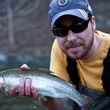
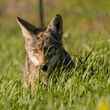
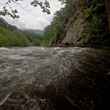


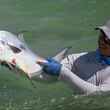
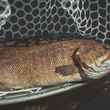


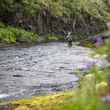
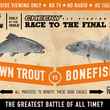



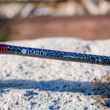
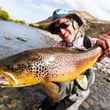



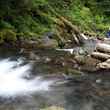
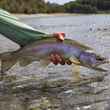




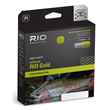
Comments